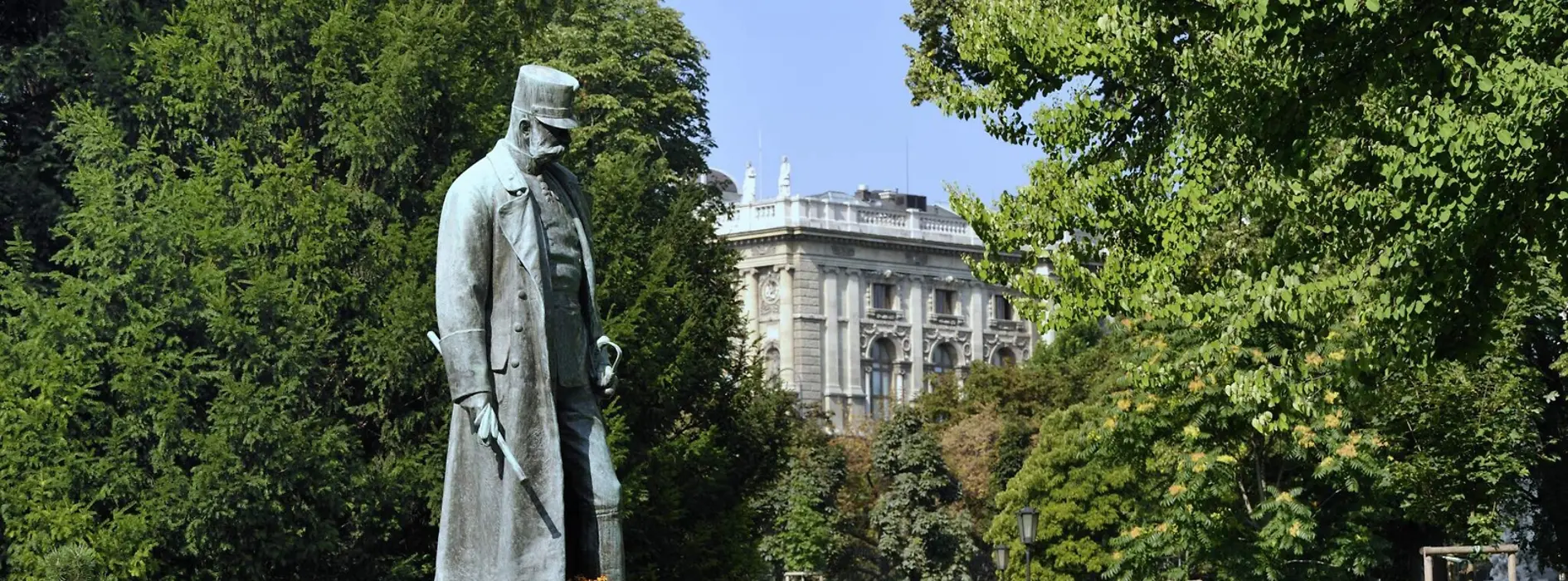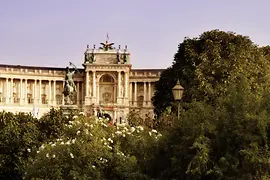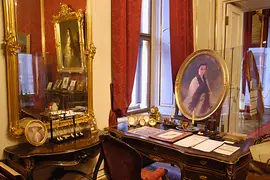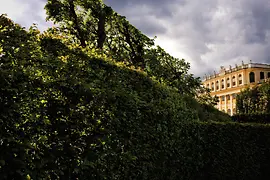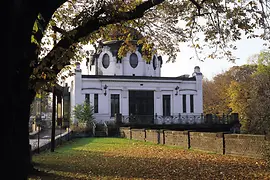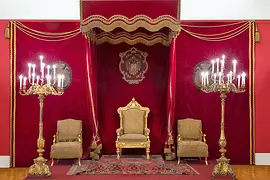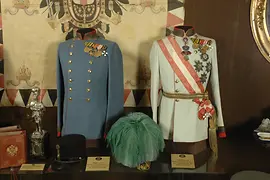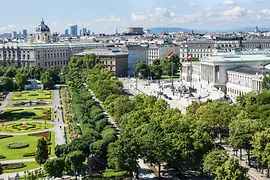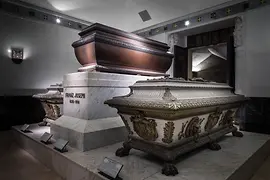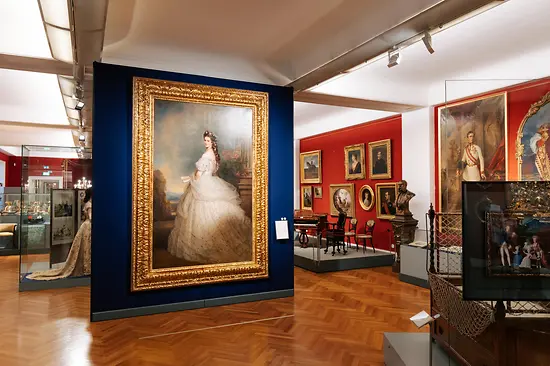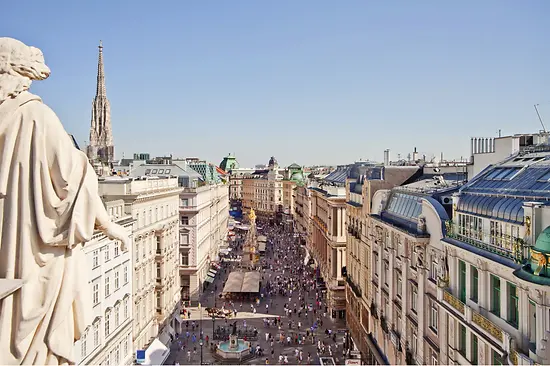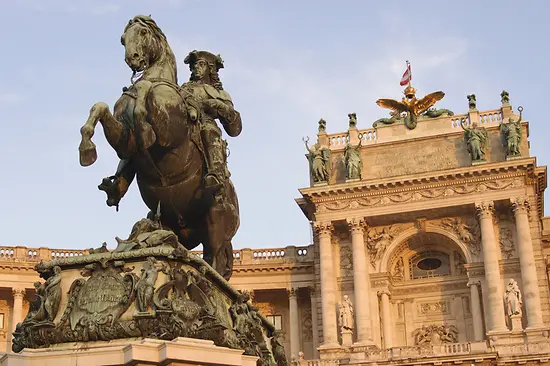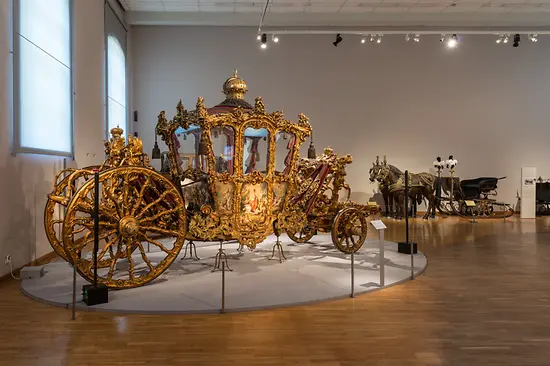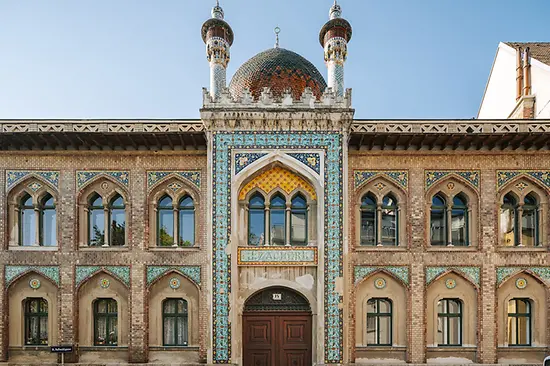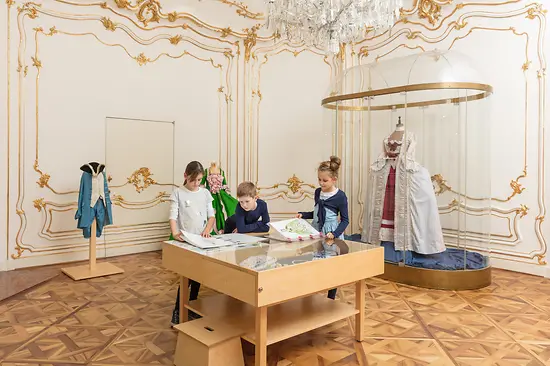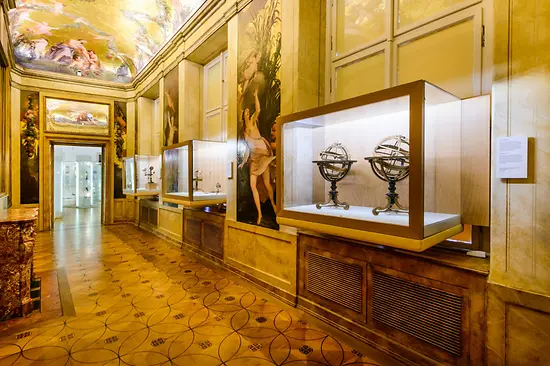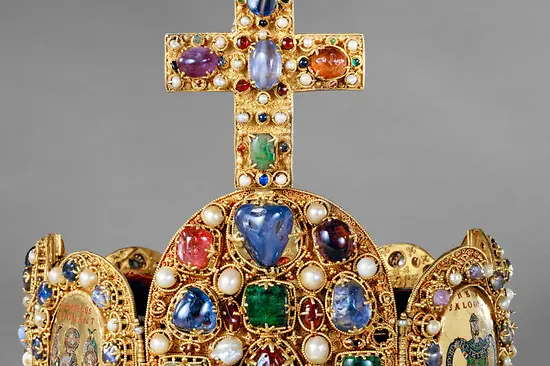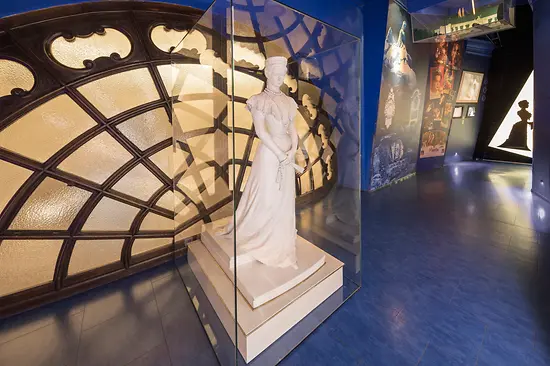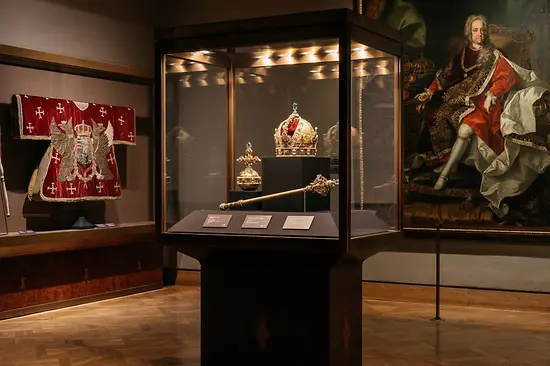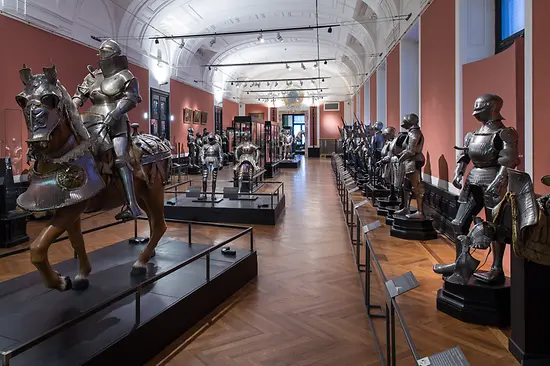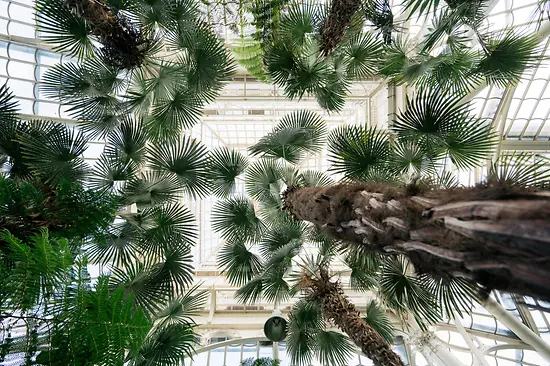On the trail of Emperor Franz Joseph in Vienna
Emperor Franz Joseph’s erstwhile private garden provides a great setting for an initial encounter with the great man. The Burggarten in Vienna’s old town contains a statue of the monarch in typical dress – in his case, military uniform. Originally unveiled in front of a barracks, it later took up residence in the park on the Ringstrasse boulevard in 1957. The statue now stands just a stone’s throw from the Hofburg, where he ruled over the Habsburg empire for 68 years. Franz Joseph lived in the complex during the winter, and the former Imperial Apartments are open to visitors. Highlights include his study, his wife Elisabeth’s drawing room and bedroom, various salons and a positively antediluvian bathroom. Also located in the Hofburg, the Imperial Treasuries is a trove of priceless items including Emperor Rudolf II’s crown, which would later be adopted as the Austrian coronation crown.
Each summer Franz Joseph relocated his entire operation to Schönbrunn Palace – where he was born (1830), spent his dotage and died (1916). Passionate about nature, he was particularly fond of the Schlosspark where he would take regular walks. As a child Franz Joseph would spend countless hours in the park with his brothers, and is reputed to have learned to swim in a pool behind the obelisk fountain. He also visited the zoo regularly. Schönbrunn Palace has 1,441 rooms, 45 of which are open to the public. The Emperor’s offices and private apartments are simple and unadorned, while the staterooms and guest apartments are the epitome of opulence. The Imperial Coach Collection at Schönbrunn Palace presents a huge range of examples of imperial transportation, from the larger-than-life imperial coach to more modest children’s sleighs.
Another related highlight, the Hofpavillon Hietzing can be found close to Schönbrunn Palace. Adorned with intricate Jugendstil (Austrian Art Nouveau) elements, the pavilion was actually a station designed by Otto Wagner for the Stadtbahn railway. Exclusively reserved for the monarch and his entourage, the imperial station building even contained a private study for the emperor. However, he only used his private station on a grand total of two occasions – today it is open to visitors. Anyone interested in finding out how the emperor really lived should head for the Vienna Furniture Museum. This unique museum contains furnishings from the royal and imperial households. The thousands of items covering some five centuries include an imperial travel throne and a prayer bench upholstered in velvet.
Other places with strong connections to the emperor include the Museum of Military History which puts painting and uniforms from the Emperor’s day on display in the Franz-Joseph-Saal, and the Votive Church which was built to thank God for saving the young Emperor’s life following a failed assassination attempt. Vienna’s Ringstrasse boulevard can also be seen as a symbol of his reign. In 1857 Emperor Franz Joseph ordered the fortifications surrounding Vienna’s city center to be demolished, and for a boulevard complete with showpiece buildings to be constructed on the grounds in front of the old walls and towers.
In-keeping with tradition, the “Old Man of Schönbrunn” was laid to rest in the Imperial Crypt, which is the final resting place of members of the Austrian Habsburg dynasty. Since 1633 a total of 149 Habsburgs, including 12 emperors and 19 empresses and queens, have been buried in the crypt beneath the Kapuzinerkirche (Church of the Capuchin Friars). Franz Joseph was the last of the emperors to be buried here. The sarcophaguses containing the remains of his spouse Empress Elisabeth and Crown Prince Rudolf are also in the chamber.
- Burggarten, 1010 Wien
Comments
Entrance via Entrance via Batthyanytor/Michaelerkuppel
Opening times
Daily 10 a.m. to 5:30 p.m.
Daily 10 a.m. to 6 p.m.
- Guided tour for children Sa - Su, 10:30 - 14:30
- Guided tour for children on holidays, 10:30 - 14:30
Accessibility
no steps
Seeing eye dogs allowed
Wheelchair accessible restroom available.
Admission free for a person accompanying a blind visitor or a visitor in a wheelchair, provided that the accompanying person is included in the ID.
The Imperial Apartments are located on the 1st floor and are accessible by elevator.
Number of steps to the first floor (Imperial Apartments): 72
- Hofburg, Schweizerhof, 1010 Wien
- info@khm.at
- http://www.kaiserliche-schatzkammer.at
Vienna City Card
Standard ticket price: 18€ / reduced ticket price: 17€
Prices
- Free admission for young people under 19 years of age
Opening times
- Mo, 09:00 - 17:30
- We, 09:00 - 17:30
- Th, 09:00 - 17:30
- Fr, 09:00 - 17:30
- Sa, 09:00 - 17:30
- Su, 09:00 - 17:30
Accessibility
no steps (Double swinging doors 200 cm wide)
Parking spaces for people with disabilities
Public parking spaces for people with disabilities on Heldenplatz
Wheelchair accessible restroom available.
Wheelchair rental (reserve at least one day ahead)
Exhibition rooms: 20 steps and elevator.
- Schönbrunner Schlossstraße, 1130 Wien
- info@schoenbrunn.at
- http://www.schoenbrunn.at
Vienna City Card
Sisi Pass (November 3, 2025 to March 26, 2026): €51.00 instead of €57.00
Classic Pass Plus: €71.00 instead of €76.00
Classic Pass (April 1 to November 2, 2025): €38.00 instead of €40.00
Tickets on www.imperialtickets.com and on site
Buy now with discount:
Opening times
- (Last entry: 16:15 h) daily, 08:30 - 17:00
- (Last entry: 16:45 h) daily, 08:30 - 17:30
- (Last entry: 16:15 h) daily, 08:30 - 17:00
Accessibility
no steps
Parking spaces for people with disabilities
at main entrance portal (Schönbrunner Schlossstrasse, 3 parking spaces), Meidlinger Tor (2 parking spaces), close to Kavalierstrakt as well as Valerietrakt (2 parking spaces) and Fürstenstöckl (1 parking space)
Seeing eye dogs allowed
Wheelchair accessible restroom available.
Free wheelchair rental – contact attendant at main portal (3 wheelchairs) or at Hietzinger Tor and at Meidlinger Tor (1 wheelchair each). Supplemental devices available for the visually impaired. Tours for visitors with with disabilities or special needs on request. Museum Sign Language Guide available in ÖGS and IS for the Imperial or Grand Tour, prior reservation recommended, further information: https://www.schoenbrunn.at/en/visitor-information/barrier-free-access
Access to all exhibition rooms: no steps. Freight elevator for extra wide wheelchairs: door width: 160 cm, cabin depth: 220 cm, cabin width: 156 cm.
Ticket Center in the Gardetrakt by the main gate, stepless access, door width: approx. 144 cm, wheelchair-accessible restroom can be reached by wheelchair platform lift – platform 110/140 cm, door width: 90 cm in the corridor area and 94 cm to the outdoors, accessible from outside with a Euro-Key.
- Schönbrunner Schlosspark, 1130 Wien
- office@zoovienna.at
- http://www.zoovienna.at
Vienna City Card
Standard ticket price: 27€
Savings: 4€
Opening times
- daily, 09:00 - 16:30
- daily, 09:00 - 17:00
- daily, 09:00 - 17:30
- daily, 09:00 - 18:30
- daily, 09:00 - 16:30
ATTENTION: Until the changeover to winter time, the March opening hours apply in October
Accessibility
no steps (Swinging doors)
no steps
3 Parking spaces for people with disabilities
Seckendorff-Gudent Weg, near entrance Tirolergarten
Seeing eye dogs allowed
Wheelchair accessible restroom available.
Tours for visitors with disabilities and special needs on request, please contact: reservierung@zoovienna.at
Assistance dogs (with ID card, vaccination certificate and identification blanket) are exempt from the dog ban. The following vaccinations are mandatory for assistance dogs at the zoo: rabies, distemper, parvovirosis, leptospirosis and contagious hepatitis (HCC). The valid vaccination certificate must be presented at the ticket office
- Schloss Schönbrunn, 1130 Wien
- info.wb@khm.at
- https://www.kaiserliche-wagenburg.at
Vienna City Card
Standard ticket price: 14€ / reduced price: 13€
Opening times
- daily, 09:00 - 17:00
- daily, 10:00 - 16:00
Accessibility
Special tours for people with special needs on request; More information: kunstvermittlung@khm.at or Tel. +43 1 525 24-5202;
Main entrance: steps (more than 3 cm), double doors (each 68 cm wide), entrance to the collection: double swinging doors, total width 130cm, exhibition area: flat floors, wheelchair-accessible. Second floor area reachable via steps (width 128 cm, 12 steps, landing, then 155 cm, 10 steps, handrail on both sides of the steps, 100 cm high). Restroom outside Coach Collection currently not barrier-free!
- Schönbrunner Schloßstraße, 1130 Wien
- https://www.wienmuseum.at/otto_wagner_hofpavillon_hietzing
Opening times
- Fr - Su, 10:00 - 13:00
- Fr - Su, 14:00 - 17:00
Closed: 1/11/2023 - 14/3/2024 & 1/5/2024
Accessibility
2 Steps (Double swinging doors 156 cm wide)
Stufenhöhe je 16cm
Seeing eye dogs allowed
Guided tours on request.
- Arsenal, Objekt 1, 1030 Wien
- contact@hgm.at
- https://www.hgm.at
Vienna City Card
Standard ticket price: 3,50€ / Reduced fee: 2,50€
Prices
- Free admission every first Sunday in the month
Opening times
- Mo, 09:00 - 17:00
- Tu, 09:00 - 17:00
- We, 09:00 - 17:00
- Th, 09:00 - 17:00
- Fr, 09:00 - 17:00
- Sa, 09:00 - 17:00
- Su, 09:00 - 17:00
- on holidays, 09:00 - 17:00
closed: Jan 1, Easter Sunday, May 1, Nov 1, Dec 24 closed from 14h, Dec 25, Dec 31
Accessibility
3 Steps
Access via ramp
2 Steps
Access via ramp
Ramp 119 cm wide
4 Parking spaces for people with disabilities
Seeing eye dogs allowed
Wheelchair accessible restroom available.
Access to Tank Garden (Panzergarten) on ground floor.
- Neuer Markt, 1010 Wien
- info@kapuzinergruft.com
- https://www.kaisergruft.com
Vienna City Card
Standard ticket price: 13€
Reduced ticket price: 10,50€
Opening times
- Mo, 10:00 - 18:00
- Tu, 10:00 - 18:00
- Mo, 10:00 - 18:00
- Th, 09:00 - 18:00
- Fr, 10:00 - 18:00
- Sa, 10:00 - 18:00
- Su, 10:00 - 18:00
1 and 2 November: 10.00 am - 2.00 pm, 24 and 31 December: 10.00 am - 4.00 pm.
1 January 12.00-6.00 pm
closed from 13.-21. January
Guided tours
Monday - Saturday
2pm and 3.30pm (German)
Monday, Wednesday and Saturday
3pm (English)
Sunday
10.30am and 2pm (German)
additionally in July and August daily 10.30 am (German)
Accessibility
no steps (Swinging doors 90 cm wide)
Seeing eye dogs allowed
Wheelchair accessible restroom available.
Guided tours for people with visual impairments are available by prior arrangement
Access to all exhibition rooms: no steps, except 3 steps to the tomb of emperor Franz Joseph and to the burial vault chapel.
The touching of objects is not permitted due to reasons of preservation.
- Andreasgasse 7, 1070 Wien
- info@moebelmuseumwien.at
- http://www.moebelmuseumwien.at
Vienna City Card
Normal ticket price (permanent and special exhibition): €18.00 / reduced price: €16.00
Admission + guided tour of the permanent exhibition incl. themed tours: €23 / reduced price: €21
Sisi Pass (Vienna Furniture Museum, Schönbrunn Palace, Sisi Museum) with the Vienna City Card for €46.00 instead of €51.00
Tickets at www.imperialtickets.com and on site
Buy now with discount:
Opening times
- Tu, 10:00 - 17:00
- We, 10:00 - 17:00
- Th, 10:00 - 17:00
- Fr, 10:00 - 17:00
- Sa, 10:00 - 17:00
- Su, 10:00 - 17:00
Accessibility
no steps (Double swinging doors 180 cm wide)
Free admission for one accompanying person for blind or wheelchair-bound visitors. Group tours for people in wheelchairs on request. Special guided tours of the furniture museum on request. For blind and visually impaired visitors: exhibits that have been approved by curators are brought into the visitor area so that they can be touched.
Wheelchairs are available free of charge at the ticket office. Seating for visitors is available in the museum. Barrier-free accessible toilets are located in the ticket hall and in the area of the permanent exhibition on the 1st floor, guide dogs are permitted. Free admission for one person accompanying blind or wheelchair-bound visitors.
Elevator 3rd-5th floor. Lifting platform to the first floor: door width: 83 cm, cabin depth: 117 cm, cabin width: 75 cm. stepless access to the restaurant / café (from the main entrance).
Guide and assistance dogs allowed
www.habsburger.net is an excellent source of information on the history and lives and times of the Habsburgs (in German and English).
